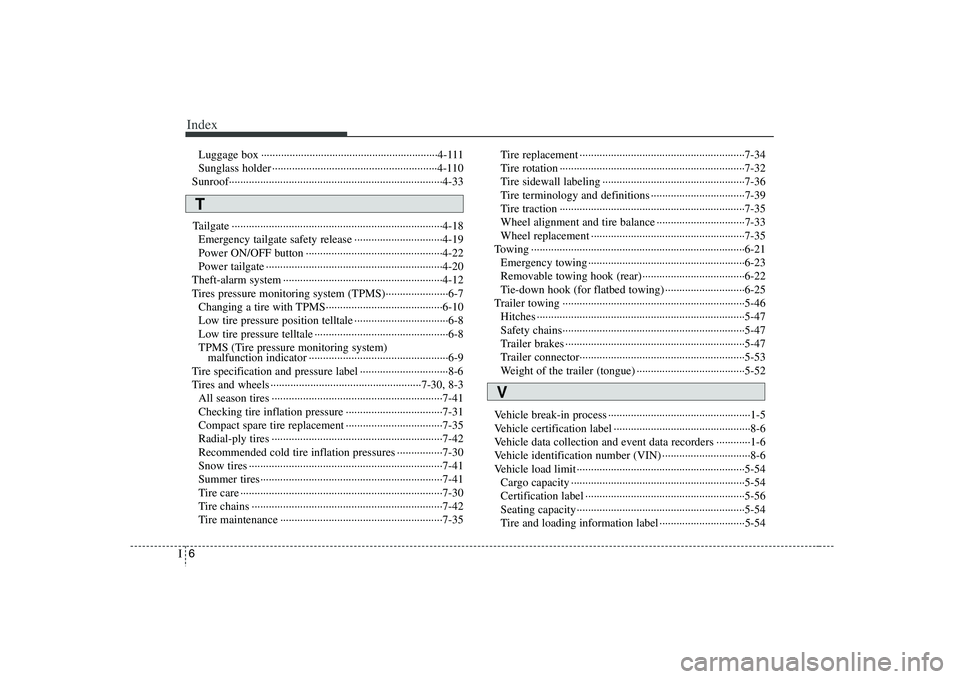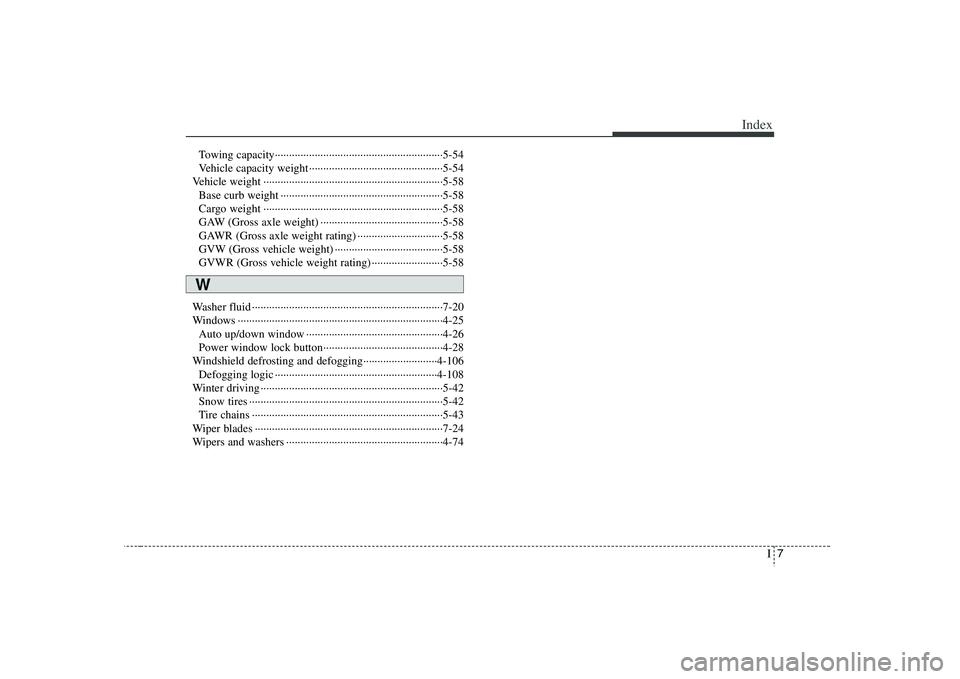2008 HYUNDAI VERACRUZ towing
[x] Cancel search: towingPage 353 of 440

What to do in an emergency24 6 Before emergency towing, check that
the hook is not broken or damaged.
Fasten the towing cable or chain
securely to the hook.
Do not jerk the hook. Apply steady and
even force.
To avoid damaging the hook, do not
pull from the side or at a vertical angle.
Always pull straight ahead. Use a towing strap less than 16 feet (5
m) long. Attach a white or red cloth
(about 12 inches (30 cm) wide) in the
middle of the strap for easy visibility.
Drive carefully so that the towing strap
is not loosened during towing.
CAUTION
Attach a towing strap to the tow
hook.
Using a portion of the vehicle
other than the tow hooks for tow-
ing may damage the body of your
vehicle.
Use only a cable or chain specifi-
cally intended for use in towing
vehicles. Securely fasten the
cable or chain to the towing hook
provided.
WARNING
Use extreme caution when towing
the vehicle.
driving maneuvers which would
place excessive stress on the
emergency towing hook and tow-
ing cable or chain. The hook and
towing cable or chain may break
and cause serious injury or dam-
age.
If the disabled vehicle is unable
to be moved, do not forcibly con-
tinue the towing. Contact an
authorized HYUNDAI dealer or a
commercial tow truck service for
assistance.
Tow the vehicle as straight ahead
as possible.
Keep away from the vehicle dur-
ing towing.
OEN066014
Page 354 of 440

625
What to do in an emergency
F080301AUNEmergency towing precautions Turn the ignition switch to ACC so the
steering wheel isn’t locked.
Place the transaxle shift lever in N
(Neutral).
Release the parking bake.
Press the brake pedal with more force
than normal since you will have
reduced brake performance.
More steering effort will be required
because the power steering system
will be disabled.
If you are driving down a long hill, the
brakes may overheat and brake per-
formance will be reduced. Stop often
and let the brakes cool off.
F080400AUNTie-down hook
(for flatbed towing)
CAUTION
If the car is being towed with all four
wheels on the ground, it can be
towed only from the front. Be sure
that the transaxle is in neutral. Do
not tow at speeds greater than 25
mph (40 km/h) and for more than 15
miles (25 km). Be sure the steering
is unlocked by placing the ignition
switch in the ACC position. A driver
must be in the towed vehicle to
operate the steering and brakes.
WARNING
Do not use the hooks under the
front (or rear) of the vehicle for tow-
ing purposes. These hooks are
designed ONLY for transport tie-
down. If the tie-down hooks are
used for towing, the tie-down hooks
or front bumper will be damaged
and this could lead to serious
injury.
OEN066016OEN066017
FrontRear
Page 364 of 440

Maintenance10 7G040200AEN-EUMAINTENANCE UNDER SEVERE USAGE CONDITIONSSEVERE DRIVING CONDITIONS
A - Repeatedly driving short distance of less than 5 miles (8 km) in normal
temperature or less than 10 miles (16 km) in freezing temperature
B - Extensive engine idling or low speed driving for long distances
C - Driving on rough, dusty, muddy, unpaved, graveled or salt- spread roads
D - Driving in areas using salt or other corrosive materials or in very cold
weatherE - Driving in sandy areas
F - Driving in heavy traffic area over 90°F (32°C)
G - Driving on uphill, downhill, or mountain road
H - Towing a Trailer, or using a camper, or roof rack
I - Driving as a patrol car, taxi, other commercial use or vehicle towing
J - Driving over 106 mph (170 km/h)
K - Frequently driving in stop-and-go conditionsENGINE OIL AND FILTER
AIR CLEANER FILTER
SPARK PLUGS
FRONT DISC BRAKE/PADS, CALIPERS AND ROTORS
REAR DISC BRAKE/PADS, PARKING BRAKE
STEERING GEAR BOX, LINKAGE & BOOTS/
LOWER ARM BALL JOINT, UPPER ARM BALL JOINT
DRIVE SHAFTS AND BOOTS
TRANSFER CASE OIL (AWD)
REAR AXLE OIL (AWD)
CLIMATE CONTROL AIR FILTER
(FOR EVAPORATOR AND BLOWER UNIT)
PROPELLER SHAFTR
R
R
I
I
I
I
R
R
R
IEVERY 3,000 MILES (5,000 KM) OR 3 MONTHS
MORE FREQUENTLY
MORE FREQUENTLY
MORE FREQUENTLY
MORE FREQUENTLY
MORE FREQUENTLY
EVERY 7,500 MILES (12,000 KM) OR 6 MONTHS
EVERY 30,000 MILES (48,000 KM)
EVERY 60,000 MILES (96,000 KM)
MORE FREQUENTLY
EVERY 7,500 MILES (12,000 KM) OR 6 MONTHS
A, B, C, D, E, F, G, H, I, KC, E
B, H
C, D, G, H
C, D, G, H
C, D, E, F, G, H, I
C, D, E, F, G, H, I, J
C, E, G, H, I, J
C, E, G, H, I, J
C, E
C, E
MAINTENANCE ITEMMAINTENANCE
OPERATIONMAINTENANCE
INTERVALSDRIVING
CONDITION
The following items must be serviced more frequently on cars normally used under severe driving conditions. Refer to the chart
below for the appropriate maintenance intervals.
R : Replace I : Inspect and, after inspection, clean, adjust, repair or replace if necessary
Page 437 of 440

Index6I
Luggage box ······························································4-111
Sunglass holder ··························································4-110
Sunroof···········································································4-33
Tailgate ··········································································4-18
Emergency tailgate safety release ·······························4-19
Power ON/OFF button ················································4-22
Power tailgate ······························································4-20
Theft-alarm system ························································4-12
Tires pressure monitoring system (TPMS)······················6-7
Changing a tire with TPMS·········································6-10
Low tire pressure position telltale ·································6-8
Low tire pressure telltale ···············································6-8
TPMS (Tire pressure monitoring system)
malfunction indicator ·················································6-9
Tire specification and pressure label ·······························8-6
Tires and wheels ·····················································7-30, 8-3
All season tires ····························································7-41
Checking tire inflation pressure ··································7-31
Compact spare tire replacement ··································7-35
Radial-ply tires ····························································7-42
Recommended cold tire inflation pressures ················7-30
Snow tires ····································································7-41
Summer tires································································7-41
Tire care ·······································································7-30
Tire chains ···································································7-42
Tire maintenance ·························································7-35Tire replacement ··························································7-34
Tire rotation ·································································7-32
Tire sidewall labeling ··················································7-36
Tire terminology and definitions ·································7-39
Tire traction ·································································7-35
Wheel alignment and tire balance ·······························7-33
Wheel replacement ······················································7-35
Towing ···········································································6-21
Emergency towing ·······················································6-23
Removable towing hook (rear)····································6-22
Tie-down hook (for flatbed towing) ····························6-25
Trailer towing ································································5-46
Hitches ·········································································5-47
Safety chains································································5-47
Trailer brakes ·······························································5-47
Trailer connector··························································5-53
Weight of the trailer (tongue) ······································5-52
Vehicle break-in process ··················································1-5
Vehicle certification label ················································8-6
Vehicle data collection and event data recorders ············1-6
Vehicle identification number (VIN) ·······························8-6
Vehicle load limit ···························································5-54
Cargo capacity ·····························································5-54
Certification label ························································5-56
Seating capacity ···························································5-54
Tire and loading information label ······························5-54T
V
Page 438 of 440

I7
Index
Towing capacity···························································5-54
Vehicle capacity weight ···············································5-54
Vehicle weight ·······························································5-58
Base curb weight ·························································5-58
Cargo weight ·······························································5-58
GAW (Gross axle weight) ···········································5-58
GAWR (Gross axle weight rating) ······························5-58
GVW (Gross vehicle weight) ······································5-58
GVWR (Gross vehicle weight rating) ·························5-58
Washer fluid ···································································7-20
Windows ········································································4-25
Auto up/down window ················································4-26
Power window lock button··········································4-28
Windshield defrosting and defogging··························4-106
Defogging logic ·························································4-108
Winter driving ································································5-42
Snow tires ····································································5-42
Tire chains ···································································5-43
Wiper blades ··································································7-24
Wipers and washers ·······················································4-74W